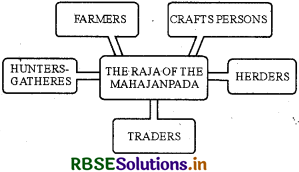RBSE Solutions for Class 6 Social Science History Chapter 5 Kingdoms, Kings and An Early Republic
Rajasthan Board RBSE Solutions for Class 6 Social Science History Chapter 5 Kingdoms, Kings and An Early Republic Textbook Exercise Questions and Answers.
RBSE Class 6 Social Science Solutions History Chapter 5 Kingdoms, Kings and An Early Republic
RBSE Class 6 Social Science Kingdoms, Kings and An Early Republic InText Questions and Answers
Page 47
Question 1.
Make a list of all those who would be present at the sacrifice? Which are the categories that are described in terms of their occupation?
Answer:
- The raja who performs sacrifices.
- Priests
- Raja's Charioteer
- Family members of the raja including his wives and sons.
- Other rajas as spectators.
- Ordinary people, the Vish or Vaishya.
Page 48
Question 2.
Why did people oppose the system of varnas?
Answer:
Varna was the division of the society in the Rig Vedic times when there were four classes. These classes were Brahmin, Kshatriya, Vaishya and Shudra. This division was majorly based on the occupations of the people. But some people opposed this division as there should be no difference amongst people on the basis of occupation. Also birth could not be the basis of varnas. Others felt that everybody should be able to perform rituals and some were against the practice of untouchability.

Page 51
Question 1.
List two ways in which the rajas of the mahajanapadas were different from those mentioned in the Rigveda.
Answer:
1. The rajas of mahajanapadas became rajas by performing very big sacrifices where as rajas in Rigveda were chosen by the jana or people.
2. The rajas of mahajanapadas had capital city, which were fortified and they also had large armies but the rajas of Rigveda did not have a capital city, palaces or armies.
Question 2.
What do you think would have been provided by hunters and gatherers ?
Answer:
- The hunters might have brought fresh meat everyday for the king.
- Gatherers might have brought forest produce like honey, berries, roots, medicinal herbs, etc.
Page 52
Question 1.
Can you think why the kings would encourage these changes ?
Answer:
The growing use of plowshare and transplantation helped to increase agricultural production. As a result, the kings were able to extract more taxes from their men. Further, it helped in maintaining a large army that was utilized in acquiring land and protecting the kingdom.

Page 53
Question 2.
In what ways were these armies different from those described in the Rigveda?
Answer:
Most of the men took part in the war, whenever required. the king had vast armies of foot soldiers, chariots, and elephants.
Page 54
Question.
In what ways was the Vajji sangha different from the other mahajanapadas ? Try and list at least three differences.
Answer:
Vajji Sangha:
- Vajji Sangha was under a different form of government known as Gana or Sangha.
- In the sangha, there were many rulers, each was called a raja.
- They met in assemblies and decide what to do, through discussions and debates.
Mahajanapada:
- They were governed by strong rulers.
- There was a single powerful ruler.
- The king took the help of ministers for all the decisions, but the final decision was taken by the king only.
RBSE Class 6 Social Science Kingdoms, Kings and An Early RepublicTextbook Questions and Answer
Let’s recall
Question 1.
State whether true or false:
(a) Rajas who let the ashvamedha horse pass through their lands were invited to the sacrifice.
(b) The charioteer sprinkled sacred water on the king.
(c) Archaeologists have found places in the settlements of the janapadas.
(d) Pots to store grain were made out of Painted Grey Ware.
(e) Many cities in mahajanapadas were fortified.
Answer:
(a) True
(b) False
(c) False
(d) False
(e) True.

Question 2.
Fill in the chart given below with the terms : hunters-gatherers, farmers, traders, craft persons, herders.
Answer:

Question 3.
Who were the groups who could not participate in the assemblies of the ganas ?
Answer:
- Women
- Dasas
- Kamma-karas (or so called shudras).
Let’s discuss
Question 1.
Why did the rajas of the mahajanapadas build forts ?
Answer:
- To defend people: People had fear of attack from other kings, so they needed protection.
- To show wealth: Some rulers wanted to show their wealth and power, so they built large and impressive walls around their cities.
- To control the territory: The people who were living inside the fortified area could be controlled easily by the kings.
Question 2.
In what ways are present-day elections different from the ways in which rulers were chosen in janapadas?
Answer:
They are different in the following ways :
- In the present day elections, people choose their leader by Universal Adult Franchise while it was not in practice in janapadas.
- In the present day, elections are held by election commission, whereas in janapads such type of institution was not present.
- In Janapada, the rajas were chosen by jana and sometimes a person became raja because of his immense physical strength, In present day, this type of selection is not possible
